Microsoft Surface Review
by Anand Lal Shimpi on October 23, 2012 9:01 PM EST- Posted in
- Tablets
- Microsoft
- Mobile
- Surface
- Windows RT
Display: Not Retina, But Still Good
Surface features a 10.6 inch, 1366 x 768 16:9 display. The physical size is a bit unusual, although the display resolution is something we’ve seen used in affordable notebooks for years now. We already know why Microsoft picked the display size (to enable better multitasking and make for a good keyboard size), but is there room for a flagship tablet with only a 1366 x 768 display resolution?
Microsoft’s response to the resolution question is that more pixels isn’t necessarily better, and that there are a number of other factors that are just as important. It also is quick to point out that a significantly higher resolution display would have increased memory bandwidth requirements, decreased UI frame rate and required a larger battery. As NVIDIA’s Tegra 3 only has a single channel LPDDR2 memory interface, driving a 2048 x 1536 panel and maintaining Microsoft’s UI performance requirements was out of the question. Apple ran into the same issue and ended up building the A5X SoC with an insanely wide memory interface to deal with it. Down the road I’d expect the memory bandwidth problem to get solved, but that still leaves a power consumption issue. Apple moved to a 42.5Wh battery in the 3rd generation iPad, a 37% capacity increase compared to the 31Wh unit in Surface. Enabling a similar panel would have pushed size and weight of Surface more than Microsoft would have liked.
Given those constraints Microsoft chose a different route with Surface. Rather than focus on pixel density it focused on improving contrast and reducing glare. Surface laminates the cover glass and LCD panel together, removing an annoying air gap that’s responsible for some reflections/glare and a reduction in brightness. Apple’s recently announced 8th generation iMac does something similar, as do a lot of high end smartphones, but Surface is among the first to do so with a ~10-inch LCD. The effect is noticeable in a contrived photo but it also results in a display that’s not half bad to look at.
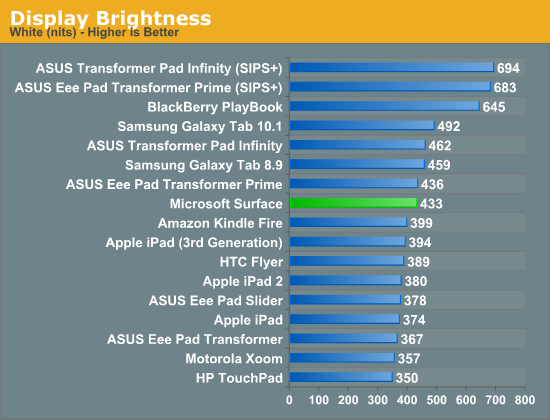
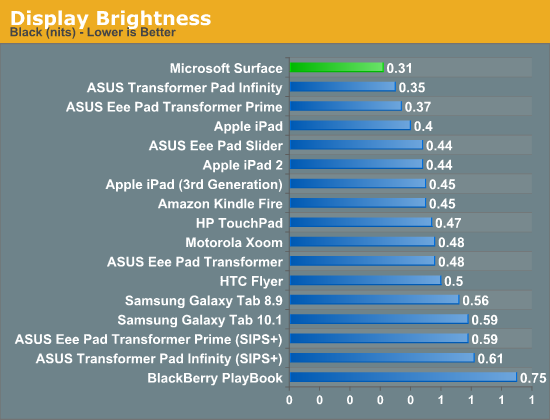
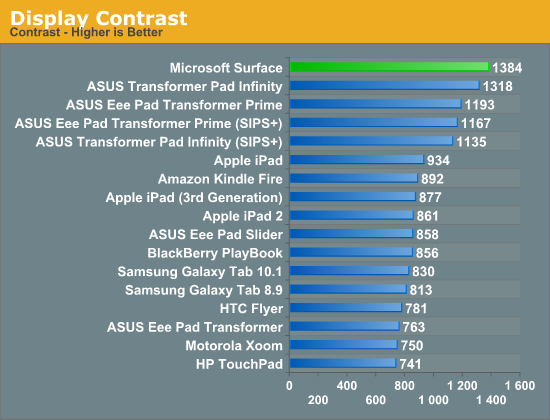
With the exception of text on web pages, the lower resolution Surface display isn’t overly bothersome. I would like something a bit higher resolution although I don’t know that matching Apple’s pixel density is absolutely necessary if Microsoft can deliver elsewhere.
Apple doesn’t just rely on resolution to sell the iPad’s Retina Display, it also happens to do quite well at accurately representing colors. I put Surface through AnandTech Senior Display Editor, Chris Heinonen’s excellent tablet/smartphone analysis workflow to see how well it did:
| CalMAN Display Comparison | ||||||
| Apple iPad (3rd gen) | Apple iPad 2 | ASUS Transformer Pad Infinity | Microsoft Surface | |||
| Grayscale 200 nits Avg dE2000 | 3.7333 | 1.3826 | 3.9881 | 3.6769 | ||
| CCT Avg (K) | 6857K | 6632K | 6632K | 6407K | ||
| Saturation Sweep Avg dE2000 | 3.193 | 6.8404 | 6.8404 | 7.3617 | ||
| GMB Colorchecker Avg dE2000 | 3.0698 | 3.8957 | 4.4177 | 5.3057 | ||
Saturation

Gamut
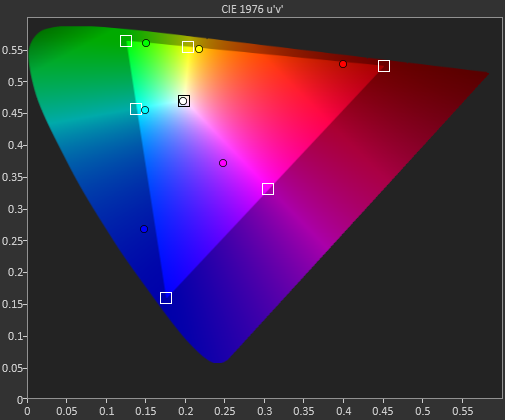
GMB Color Checker
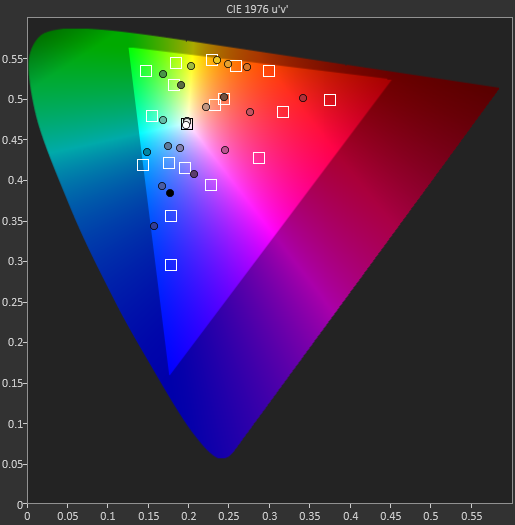
Grayscale accuracy is slightly better on Surface compared to the iPad, however the rest of the accuracy metrics show Apple’s tablet ahead of Surface.
This isn’t to say that Surface’s display is bad, in fact I think it’s quite good and I’d argue that it was never a problem in my testing, but it’s definitely not the best on the market today. I’m also not sure how much of this has to do with Microsoft’s panel selection vs. software calibration. None of my calibration tools work under Windows RT so I couldn’t really tell you.
I did reach out to Microsoft and they did say that some of my values in the charts below looked a little off. I’ll be rerunning data on another Surface sample as soon as I get a chance to.










235 Comments
View All Comments
kyuu - Thursday, October 25, 2012 - link
Apple reviews came a week or more after the product was released, not pre-release. Also, they're doing a separate review of WinRT. Unlike Apple, the OS and hardware do not go hand-in-hand (i.e. there are OEMs), so reviewing the hardware and OS separately makes sense.amdwilliam1985 - Tuesday, October 23, 2012 - link
Where is the thumbs up button when you needed one.It's been a while since I've enjoy Anand's writing(too much Apple lately). Read every single word in this great article. My emotion was like a roller coaster reading through the pages. I was sure I'm going to get one at the beginning of the article. And then reading about the "good enough" screen, the power/battery connector, the HDMI port, I was like, maybe next generation. Then moving on with software integration and office, I have my hopes up again. Finally seeing Atom performance preview and the upcoming core x86, I'm definitely holding my horse/breath.
Thanks again for an hour of great reading. I'm in NYC, so I'm planning on seeing the surface on the launch day/evening with my girlfriend.
thomas-hrb - Tuesday, October 23, 2012 - link
I wonder what the maximum size MicroSD card the surface can handle. 32/64 GB is a bit small for a device that I would like to replace my laptop with. But if it could take a 64GB MicroSD like http://au.sandisk.com/products/mobile-memory-produ... then that resolves my issues.Although I intend to hang on for the pro version, as I have a lot oc x86 software I would like to run.
Chris-Simmons - Wednesday, October 24, 2012 - link
All Surfaces use microSDXC so they can take up to 2TB as per the microSDXC spec. I believe the largest microSDXC card available currently is 128GB but that is only for commercial customers, 64GB is the largest for retail. We are just waiting on larger cards to become available.jibz - Tuesday, October 23, 2012 - link
Quick question I didn't see answered in the review: how easy is it to use as a multi user device? One thing that has always bothered me with an iPad or any other tablet is that I can't have different accounts for different family members. So if I install GTA, it'll be available for the kids, I don't have my own bookmarks in my browser, etc. How is Surface/Win RT doing from that point of view?WP7Mango - Wednesday, October 24, 2012 - link
I can give you a detailed answer...Firstly, setting up for multiple users is very easy. The main user is the administrator and the administrator can add further users in the Settings page. Once a user is added, then it's just a case of that new user logging in using either a password, a PIN, or a picture password.
Each user has their own settings, their own apps, their own Start screen layout and background image, their own email accounts, their own contacts in the People hub, their own social network accounts, their own app data, their own bookmarks, etc etc. When one user installs an app, if another user subsequently wants to install the same app then it doesn't get downloaded again - instead, new seperate app settings are created for the new user. So if you are playing a game for example, then your saved games will be seperate from another user's saved games. If you delete a user, only their data is deleted and yours remains intact.
Bottom line is that multi-user works very well.
kyuu - Thursday, October 25, 2012 - link
Thanks for the detailed answer on that!karasaj - Tuesday, October 23, 2012 - link
You mentioned that typing speedily on Surface could bring up some heavy CPU usage: do you think that this really hampers Surface's user experience (would it be an issue) or is it merely an example of MS office 2013 nearly taxing Tegra to its limits?I.E. when typing speedily did CPU usage go up but it remained smooth, or was there a noticeable slowdown? The only things I can imagine doing with Surface are MS office, netflix (HD video), and youtube/IE. Do you think any of those feel too slow/laggy to be detrimental?
VivekGowri - Tuesday, October 23, 2012 - link
Based on my experience with the VivoTab RT (nearly identical hardware/software - Tegra 3 + Windows RT) it's the latter - I saw weirdly high CPU utilization, but no typing lag. Anand mentioned getting some with the Surface, but nothing too drastic if I remember right.karasaj - Tuesday, October 23, 2012 - link
Fantastic. I'm not too worried about high cpu usage as long as there's no lag, although it does seem like that establishes a "lower limit" for RT hardware. Do you think this high cpu usage would have a worse effect on battery life than say the wifi browsing battery life test for example? (I feel like no, but cpu usage shouldn't be too too high there)